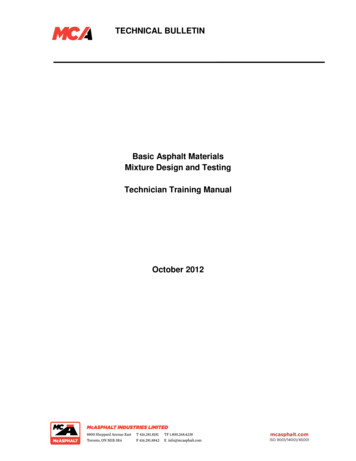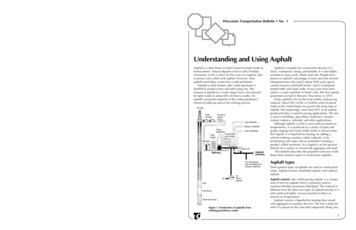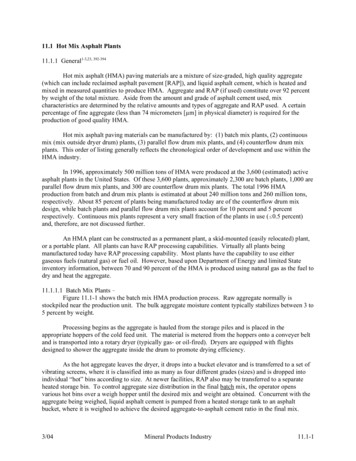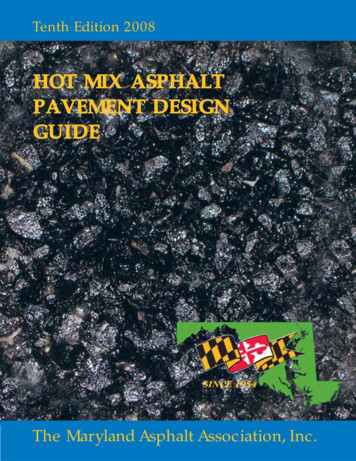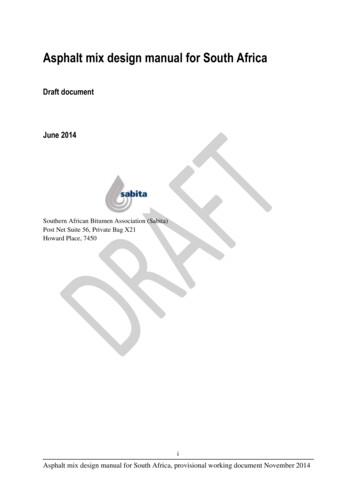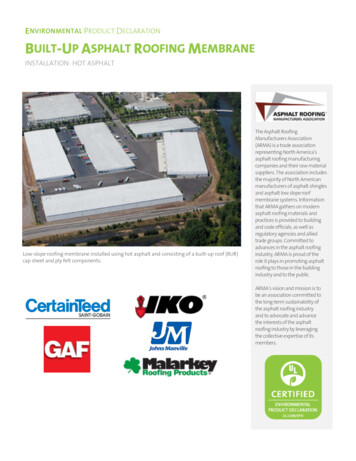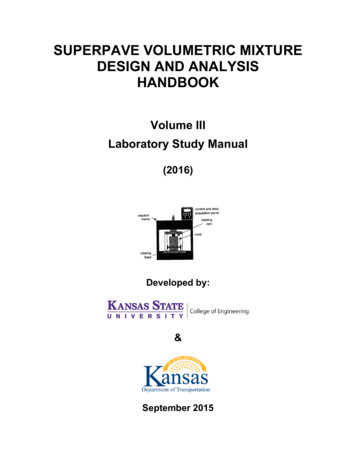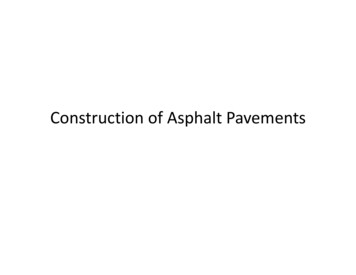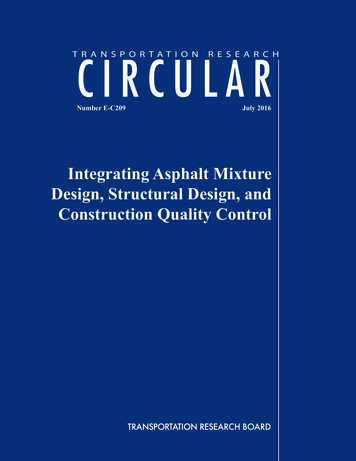
Transcription
T R A N S P O R TAT I O NNumber E-C209R E S E A R C HJuly 2016Integrating Asphalt MixtureDesign, Structural Design, andConstruction Quality Control
TRANSPORTATION RESEARCH BOARD2016 EXECUTIVE COMMITTEE OFFICERSChair: James M. Crites, Executive Vice President of Operations, Dallas–Fort WorthInternational Airport, TexasVice Chair: Paul Trombino III, Director, Iowa Department of Transportation, AmesDivision Chair for NRC Oversight: Susan Hanson, Distinguished University ProfessorEmerita, School of Geography, Clark University, Worcester, MassachusettsExecutive Director: Neil J. Pedersen, Transportation Research BoardTRANSPORTATION RESEARCH BOARD2016–2017 TECHNICAL ACTIVITIES COUNCILChair: Daniel S. Turner, Emeritus Professor of Civil Engineering, University of Alabama,TuscaloosaTechnical Activities Director: Ann M. Brach, Transportation Research BoardPeter M. Briglia, Jr., Consultant, Seattle, Washington, Operations and Preservation GroupChairMary Ellen Eagan, President and CEO, Harris Miller Miller and Hanson, Inc., Burlington,Massachusetts, Aviation Group ChairAnne Goodchild, Associate Professor, University of Washington, Seattle, Freight SystemsGroup ChairDavid Harkey, Director, Highway Safety Research Center, University of North Carolina,Chapel Hill, Safety and Systems Users Group ChairDennis Hinebaugh, Director, National Bus Rapid Transit Institute, University of SouthFlorida Center for Urban Transportation Research, Tampa, Public TransportationGroup ChairBevan Kirley, Research Associate, Highway Safety Research Center, University of NorthCarolina, Chapel Hill, Young Members Council ChairD. Stephen Lane, Associate Principal Research Scientist, Virginia Center for TransportationInnovation and Research, Design and Construction Group ChairHyun-A C. Park, President, Spy Pond Partners, LLC, Arlington, Massachusetts, Policy andOrganization Group ChairHarold R. (Skip) Paul, Director, Louisiana Transportation Research Center, LouisianaDepartment of Transportation and Development, Baton Rouge, State DOTRepresentativeRam M. Pendyala, Frederick R. Dickerson Chair and Professor of Transportation, GeorgiaInstitute of Technology, Planning and Environment Group ChairStephen M. Popkin, Director, Safety Management and Human Factors, Office of theAssistant Secretary of Transportation for Research and Technology, Volpe NationalTransportation Systems Center, Cambridge, Massachusetts, Rail Group ChairRobert Shea, Senior Deputy Chief Counsel, Pennsylvania Department of Transportation,Legal Resources Group ChairEric Shen, Director, Southern California Gateway Office, Maritime Administration, LongBeach, California, Marine Group Chair
TRANSPORTATION RESEARCH CIRCULAR E-C209Integrating Asphalt Mixture Design, StructuralDesign, and Construction Quality ControlPrepared byHarold Von Quintus and Kevin D. HallIn collaboration withFrank Fee, Erdem Coleri, Michael Heitzman,Richard May, Nathan Morian, Elie Y. HajjFor theStanding Committee on Characteristics ofAsphalt Paving Mixtures to Meet Structural RequirementsJuly 2016Transportation Research Board500 Fifth Street, NWWashington, D. C.www.TRB.org
TRANSPORTATION RESEARCH CIRCULAR E-C209ISSN 0097-8515The Transportation Research Board is one of seven programs of the National Academies of Sciences,Engineering, and Medicine. The mission of the Transportation Research Board is to provide leadership intransportation innovation and progress through research and information exchange, conducted within a setting that isobjective, interdisciplinary, and multimodal.The Transportation Research Board is distributing this E-Circular to make the information contained hereinavailable for use by individual practitioners in state and local transportation agencies, researchers in academicinstitutions, and other members of the transportation research community. The information in this circular was takendirectly from the submission of the authors. This document is not a report of the National Academies of Sciences,Engineering, and Medicine.Design and Construction GroupD. Stephen Lane, ChairAsphalt Materials SectionRebecca S. McDaniel, ChairCharacteristics of Asphalt Paving Mixtures to Meet Structural Requirements CommitteeElie Y. Hajj, ChairAla R. AbbasHossein AjidehImad Al-QadiJames AndersonAlex ApeagyeiWilliam BarstisAmit BhasinPhillip BlankenshipAndrew BrahamGhassan R. ChehabErdem ColeriShongfao DaiEshan DaveStacey DiefenderferAmy Epps MartinJennifer FoxlowChuck GemayelAdam HandY. Richard KimYong-Rak KimNiki KringosMuhammed Emin KutayHyun Jong LeeEyal LevenbergJenny LiuLouay N. MohammadNathan E. MorianBrian ProwellReynaldo Roque*Hamid SadraieRoberto SoaresRajarajan SubramanianNam TranBenjamin UnderwoodWilliam R. VavrikHaifang WenJeffrey WitheeHabtamu Zelelew*Emeritus MemberTRB StaffFrederick D. Hejl, Engineer of Materials and ConstructionJoanice Johnson, Associate Program OfficerAngela Christian, Program CoordinatorTransportation Research Board500 Fifth Street, NWWashington, D. C.www.TRB.orgLea Camarda, Production Editor; Jennifer Correro, Proofreading and Layout
PrefaceThis e-circular provides an overview of some of the benefits and issues related to integratingasphalt mixture and structural design under the low-bid process in the United States. Thee-circular is grouped into five areas:1. An overview of the mechanistic–empirical (M-E) structural design process for bothnew pavements and overlays, focusing on the Mechanistic–Empirical Pavement Design Guide(MEPDG).2. Potential benefits of the integrated design procedure, in terms of pavementperformance and in terms of complexity and equipment costs.3. A listing and discussion of some of the practical issues and impediments for adoptingan integrated design system related to materials characterization and structural design.4. Asphalt mixture properties that are common to the structural and mixture designprocess and how those properties affect distortion, fracture, and other pavement distresses.5. Potential costs and time to complete an integrated design and the commercialresources that will be needed on a day-to-day basis; in other words, the practical complexities ofthe process, and the equipment needed in support of that integrated design procedure.This volume is targeted for agency, consultant, and industry engineers involved inpavement design, asphalt materials, and construction specifications for flexible pavements andasphalt overlays.The opinions and recommendations are those of the authors of this e-circular and not ofthe standing committee sponsoring this document or of the Transportation Research Board.i
ContentsIntroduction .1Benefits of an Integrated Design System .2Mechanistic–Emperical Design Methodology and Overview .3Impediments to Implementing an Integrated Design System .11Design Time and Effort: Is It Worth the Added Effort? .19Design and Construction: Important Parameters . 21Summary . 22Endnotes, References, and Resources .25iii
IntroductionThe asphalt mixture design process most common in the United States is to have thecontractor responsible for the asphalt mixture design, while the agency maintainsresponsibility for the structural design and confirming the mixture design. Researchers andconsultants have recommended for decades that asphalt mixture and structural design beintegrated into one system (1–2). Unfortunately, these two operations remain independentfunctions—even when both are the responsibility of the agency or same organization on a dayto-day basis.The major reason for this independence is that most agencies use the 1993 AASHTODesign Guide for structural design and the Superpave–gyratory volumetric method for mixturedesign (3). These design procedures are based on and use different material properties and designcriteria. As a result, it is difficult to determine or know what impact asphalt mixture volumetricproperties have on the structural layer coefficients. Thus, some asphalt mixtures placed have notperformed as expected and the reliability of the structural design is unknown.Presently, there is a move to use structural design procedures that are based on M-Eprinciples. The latest one was developed under NCHRP 1-37A: Development of the StructuralDesign Procedure for New and Rehabilitated Pavement Structures; referred to as the M-EPavement Design Guide. These procedures use both volumetric and fundamental materialproperties, such as modulus and strength, to characterize the asphalt mixture.There has been extensive work over the years to optimize the asphalt mixture propertiesfor maximizing service life of new flexible pavements and asphalt overlays of both flexible andrigid pavements. The new MEPDG is one procedure that has the capability to tie mixture designto structural design to performance-related specifications.1
Benefits of an Integrated Design SystemThe following list includes some of the benefits that are likely to come from implementationof an integrated structural and asphalt mixture design system, assuming that thespecifications are enforced during construction.1. Comprehensive approach to pavement design considering structural and materialproperties, as opposed to a thickness design procedure that provides the ability to directlyconsider different design features and their impact on reducing surface distress.2. Application of structural and mixture design to construction operations and materialspecifications.3. Performance that is based on distress and on ride quality that can be quantified.Performance-related specifications can be developed from measurements used in the designprocedure and failure criteria used.4. Ability to incorporate available paving materials and innovative materials anddetermine the effect of noncompliance of materials on performance. The system also providesagencies with the ability to extrapolate from limited field and laboratory studies.5. Establishment of acceptance criteria and specification limits that are based on thedesign procedure giving weight to the design criteria and specification limits, allowing an agencyto quantify pay factors—both incentives and penalties.6. Assistance in development of performance-related or -based specifications and thecriteria used in the specifications. This benefit can also be used to help establish policy decisionson technical as well as nontechnical issues.2
Mechanistic–Empirical Design Methodology and OverviewFigure 1 is a conceptual schematic of the three-stage design process of the MEPDG. Thegeneral logic of the pavement prediction system is a combination of five basic modules thatare common to most M-E design procedures:1.2.3.4.5.Climatic module;Traffic module;Material characterization module;Structural response module; andTransfer functions and the distress–performance prediction module.The above modules, the input scheme, and calibration parameters are discussed in thefollowing sections of this e-circular.INPUTS MODULEThe MEPDG uses a hierarchical approach for determining the inputs that are required to executethe program and predict pavement deterioration over time. There are three hierarchical levels ofinput for most parameters, which are defined below. Level 1. Level 1 input values are used when the designer has specific measures of theinput parameter for the project. Level 1 input values are site specific inputs and considered themost accurate, because they are determined from actual measurements from the site or project.Obtaining Level 1 input values require more resources and time than the other levels. As anexample, Level 1input values would include laboratory measured dynamic modulus of asphaltmixtures. Level 2. Level 2 input values are used when the designer has a modest or moderateindications of the input parameter for the project. This level could be used when resources ortesting equipment are not available for tests required for Level 1. Level 2 input values aredetermined from regression equations or the use of regional values—they are not projectspecific. As an example, Level 2 input values would include calculating the dynamic modulusfor an asphalt mixture from volumetric and material properties. Level 3. Level 3 input values are used when the designer has limited informationregarding the input parameter for the project. Level 3 input values are the least accurate becausethey are determined from default values—a best-guess value provided in the program. As anexample, Level 3 input values would include estimating the dynamic modulus for an asphaltmixture from the performance grade of the asphalt and gradation.This hierarchical approach for defining the inputs to the program was adopted to simplifyand facilitate the implementation process of the MEPDG. This approach will allow agencies withlittle experience in more-advanced materials characterization to use the program with a relativelylow investment cost—a definite advantage. The hierarchical approach, however, complicates thecalibration–validation process and definitely increases the number of data elements that need to3
4TR Circular E-C209: Integrating Asphalt Mixture Design, Structural Design, and Construction Quality ControlNew PavementDesign and AnalysesPART 1: EVALUATIONRehabilitation Designand AnalysesINPUTS FOR DESIGNSite Investigations:Borings and field testingSoils testing in laboratoryDrainageVolume changeFrost heavePaving materialsDesign–failure criteriaClimate–Environment AnalysisTemperatureMoistureNew Materials AnalysisHot-mix asphaltPortland cement concreteCementitious materialsUnbound granular materialsSoils–embankment materialsTraffic AnalysisTruck classification and volumeAxle load distributionForecastingSelect Trial PavementDesign StrategiesPavement Evaluation:Distress surveysNondestructive testingRide quality testingBorings and coresMaterials testingDesign–failure criteriaPART 2: ANALYSISModify designfeatures ormaterialsPavement response modelCalculate stresses, strains, deflectionsNOCalculate incremental damageHas failurecriteria beenmet?Distress transfer functions andpavement performance modelsReliability analysisYESPART 3: STRATEGY SELECTIONEngineering andconstructability analysisViable design alternativeSelectStrategyLife-cyclecost analysisPolicy issues and decisionsFIGURE 1 Conceptual schematic of the three-stage design process for the MEPDG.
M-E Design Methodology and Overview5be considered in developing the schema for the global database for refining M-E design andanalysis procedures.CLIMATIC MODULEThe climatic module predicts the spatial and temporal variations of temperature and moisturecontent within the pavement structure and foundation. The climatic or environmental effectsmodel embedded in the MEPDG is the Enhanced Integrated Climatic Model (EICM), developedby the University of Illinois. The climatic data needed for this model comes from actual orvirtual weather stations.TRAFFIC MODULEThe MEPDG considers truck traffic loading in terms of axle load spectra for each axle type(single, tandem, tridem, and quadruple axles). The truck traffic module is used to compute theaxle load spectra: the number of axle applications within each axle load increment for each axletype. The model uses the FHWA standard axle load increments for each axle type and thestandard truck classes 4 through 13. The number of axle applications by axle type within eachload interval is determined within specific time intervals on a daily basis. The number of axleloads is increased by a growth factor for each year in the design–analysis period.MATERIALS CHARACTERIZATION MODULEThe material characterization module describes how the various materials in the pavementsystem respond to traffic loading and environmental changes. Different material characterizationmodels are required for the different categories of materials in the pavement cross section (e.g.;asphalt mixture, unbound materials, stabilized layers). The major material characterizationmodels for flexible pavements include the following: Asphalt mixture—loading rate, temperature, and aging-dependent linear elasticmaterial as characterized by the complex modulus (E*), phase angle (φ), and Poisson’s ratio (ν).The materials that are applicable to this category include dense- and gap-graded asphalt mixture;asphalt-treated or stabilized materials; open-graded or asphalt-treated permeable base; and coldmix asphalt. Unbound materials (base, subbase, subgrade)—either a linear elastic materialcharacterized by Young’s modulus (E) and ν or a stress-dependent nonlinear elastic materialcharacterized by stress-sensitivity parameters k1, k2, k3, Poisson’s ratio (ν), and a tension cut-offcriterion. The materials that are applicable to this category include crushed stone, pit runaggregate, sand and other base and subbase aggregates, as well as subgrade soils. Stabilized materials (base, subbase)—a stiffness-degrading linear elastic materialcharacterized by E and ν and a stiffness degradation function. The materials that are applicableto this category include portland cement concrete (PCC), cementitious treated or stabilized base,and open-graded or cement-treated permeable base.
6TR Circular E-C209: Integrating Asphalt Mixture Design, Structural Design, and Construction Quality ControlThe material characterization module is generally considered to be the most important tothe performance predictions because it affects, to some degree, all components of the system.This one module must also be tied to the asphalt mixture design method in preparation for anintegrated design system.STRUCTURAL RESPONSE MODULEThe structural response module calculates the stresses, strains, and deflections due to trafficloads and environmental influences. Environmental influences may be direct (e.g., strains due tothermal expansion or contraction) or indirect via effects on material properties (e.g., changes instiffness due to aging, temperature, or moisture effects).The MEPDG contains two pavement response models for flexible pavements. TheJULEA multilayer elastic theory program is used in cases where all of the unbound layers in thepavement are treated as linear elastic. The DSC2D nonlinear finite element program is used incases where stress dependency of the unbound material is to be considered in the performance ordistress calculations. The JULEA program was used in calibrating the distress prediction models,because it is likely to be used for most pavement designs and analyses. These structural responsemodels require several inputs, including: Traffic loading in terms of the axle load distribution for each axle type, and the wheelload location and tire pressure; Pavement cross section, including material type and layer thickness; Poisson’s ratio for each layer; Young’s modulus for each layer (determined from the dynamic modulus master curvefor asphalt mixture materials, resilient modulus for unbound materials, and the elastic modulusfor PCC materials); Interface friction between adjacent layers; and Coefficient of thermal expansion [for asphalt concrete (AC) and PCC surfacematerials].Given these inputs, the structural model calculates stresses, strains, and displacements atcritical locations in the pavement and foundation layers. Air temperatures, rainfall, and otherclimatic parameters are also needed and extracted from actual weather stations to calculate someof the above inputs. For example, the elastic modulus of asphalt mixtures varies with depth andseason.This approach allows the use of an elastic modulus within a given time period, such as amonth, that is representative of that time increment. Thus, the dynamic modulus of asphaltsurface layer is much lower in the summer than in winter. This procedure also allows for theasphalt materials to age or oxidize with time. This is modeled so that the dynamic modulus ( E* )of the asphalt mixture is constantly increasing with time. The resilient modulus of an unboundbase course and fine-grained soil vary with degree of saturation. The EICM calculates the changein moisture content over time and uses this change in moisture content to vary the resilientmodulus of the unbound materials and soils.
M-E Design Methodology and Overview7DISTRESS PREDICTION MODULES AND TRANSFER FUNCTIONSThe distress prediction modules utilize the transfer functions to convert the calculated pavementresponses into predicted performance. This operation represents the backbone of the M-E designand analysis procedure, as well as any other model based on M-E principles.As a simple example, to illustrate the concept of integrating structural design and mixturedesign, the following two Asphalt Institute models are utilized.For fatigue, the number of strain repetitions to failure (Nf) is determined by the followingequation. A model similar to this one is used in the MEPDG.Nf 18.4 (C) (0.004325) (εt–3.291) ( E* –0.854)(1)whereεt the maximum horizontal tensile strain created at the bottom of the AC layer (in./in.); E* the dynamic modulus of the AC (psi);C a factor used to incorporate the effect of the volumetric mix design parameters of theAC 10M, M 4.84 [(Vb/Vv Vb) – 0.69];Vb the percent volume of asphalt binder in the mixture; andVv the percent volume of air voids in the mixture.For subgrade rutting, the number of strain repetitions to failure is determined by thefollowing equation:Nf 1.365 10–9 εc–4.477(2)where εc is the maximum vertical compressive strain created at the top of the subgrade.For dynamic modulus, the following default relationship is included in the MEPDG forthe user to utilize if no dynamic modulus is available: E* f (asphalt binder viscosity, load frequency, percent air voids, percent effective bitumencontent, percent aggregate retained on the 19-mm sieve, percent aggregate retained on the9.5-mm sieve, percent aggregate retained on the 4.75-mm sieve, percent aggregate passingthe 0.075-mm sieve)An integrated design process would work by doing numerous iterations of runningmodels such as these. To start, the stress–strain pavement structural analysis model (i.e., layeredelastic, finite element) would be used to calculate the critical strains in the pavement (εt, εc) usingrelevant traffic inputs as well as the material characteristics adjusted by the climactic model. Theasphalt mixture stiffness would either be measured E* data or a calculated E* from the defaultmodel, using the specific asphalt binder grade (viscosity), aggregate gradation, asphalt bindercontent, and percent air void information obtained from the mix design. Next, the fatigue lifewould be determined utilizing εt from the structural analysis model, the E* , and the Vb and Vvobtained from the mix design in the fatigue equation into the fatigue transfer function. The E* used also affects the magnitude of εt. Then the subgrade rutting service life would be determined
8TR Circular E-C209: Integrating Asphalt Mixture Design, Structural Design, and Construction Quality Controlbased on the εc from the structural analysis model, which is also affected by the E* of the AClayers, the overall structural cross section, traffic loads, and the temperature.If the resulting service lives obtained (for fatigue or subgrade rutting) are not adequate forthe pavement facility to be constructed, then the design team has many options at their disposalto adjust. The thicknesses of the various layers could be increased as in the past. However, nowthat an integrated design system is available, the team could also discuss making changes to themix design, such as asphalt binder content, air voids, binder grades, aggregate gradation. Anintegrated design system provides the tool to investigate how each of these parameters impact theultimate performance of the pavement.Eventually, with time and experience, a feedback loop of information resulting fromthese iterative designs may lead to changes in the way an agency operates. After observing howperformance is directly affected by the mixture volumetrics, the agency may change the waythey do mix design by modifying the mix design criteria, the targets which are used to create theultimate job mix formula. The team could also look at other more innovative materials in the ACcomponent of the entire cross section to change the volumetric requirements, E* (and indirectlythe calculated critical strains), or the performance prediction equation itself.Ultimately, with this information feedback, the agency may become more aware of whichmix and structural design parameters are more sensitive to causing an impact on performanceand how sensitive each parameter is. By knowing this sensitivity and verifying the accuracy ofthe design method, the design team may want to institute or modify the construction qualityassurance pay factor system used to penalize or award bonuses to the paving contractor.Different parameters may come to light or the existing parameters may need to be weighteddifferently. All of this development would take time and verification of course, but the evolvingtool to assist with making these important decisions, the integrated design system, would beavailable for all departments in an agency to work together and learn together.The MEPDG is an even more complete procedure, which includes the capability toaccumulate damage on a monthly basis (or bimonthly, depending on frost conditions) over theentire design period. This approach attempts to simulate how pavement damage occurs in nature,incrementally, load by load, over continuous time periods. By accumulating damage monthly,the design procedure is comprehensive.The MEPDG includes transfer functions for permanent deformation or rutting, loadrelated cracking, and nonload related cracking. Smoothness is predicted from regressionequations. The final output from the prediction system is magnitude of pavement distress versustime. The following items are brief descriptions of the prediction models relative to thecalibration of the MEPDG and the future refinement of that model. Distortion or rutting. The rut depth prediction models are based upon empiricalrelations between rut depths measured at the surface and mechanistically computed elastic strainsin each pavement layer and foundation. The prediction model for asphalt mixture uses theconcept of resilient to plastic strain ratio with number of load repetitions. The rutting modelconsiders both volumetric rutting (that is, the predominately linear relationship between thelogarithm of the inelastic strain and number of load cycles) in each layer and the importantbehavior associated with tertiary flow (or plastic flow) of asphalt mixtures. Permanentdeformations are computed in each layer interval and then summed to predict the ruttingobserved at the surface.
M-E Design Methodology and Overview9 Fatigue cracking. The load-related cracking prediction models are based uponempirical relations between area and longitudinal cracking in the wheelpaths and a computedcritical strain in the AC layers. The fatigue-cracking prediction model is based on the classicalconcept of microfracture propagating from the bottom of the AC layer, but also considers theongoing developments to include more-recent concept of fatigue cracking initiating at the surfaceand propagating downward under NCHRP 1-52. Thermal cracking. The thermal cracking prediction model is based on an enhancedversion of the model developed under the SHRP. This model is based on fracture mechanics andcrack propagation law, which is also one of the model forms considered for fatigue cracking. Thegrowth of thermal cracks in the AC layer is predicted using the Paris law from fracturemechanics. Ride quality. Pavement deterioration is quantified in terms of individual distresses(rutting, fatigue cracking, thermal cracking), and in terms of roughness or ride quality. Ridequality, as measured by the international roughness index (IRI), is calculated from thesepredicted and other distresses.GLOBAL AND LOCAL CALIBRATION PARAMETERSAlthough the MEPDG provides for an accurate simulation of the pavement cross section, thecalibration and validation of the prediction models was an essential step in giving the designanalysis credibility. The calibration and validation of the above prediction models wasconsidered by many to be the most important activities to establish confidence in the designprocedure and facilitate its implementation, acceptance, and adoption. Furthermore, it iscommonly believed that the prediction models and design analysis procedure will not beaccepted for routine use by the highway community if the validation results do not demonstratereasonable correspondence between the field-observed and predicted distress levels.The calibration–validation process for each of the distress prediction models wascompleted using test sections within the long-term pavement performance (LTPP) program.Although the LTPP database is one of the most comprehensive databases that have been puttogether on a global scale, it does have some limitations regarding validation of M-E distressprediction models. A few of the limitations are noted below. Rutting. Trenches needed to accurately determine the precise rutting componentswithin the AC layer, all unbound paving layers, and foundation were not conducted as a part ofthe LTPP program and were outside the scope of work fo
an integrated design system related to materials characterization and structural design. 4. Asphalt mixture properties that are common to the structural and mixture design process and how those properties affect distortion, fracture, and other pavement distresses. 5. Potential costs and time to complete an integrated design and the commercial

